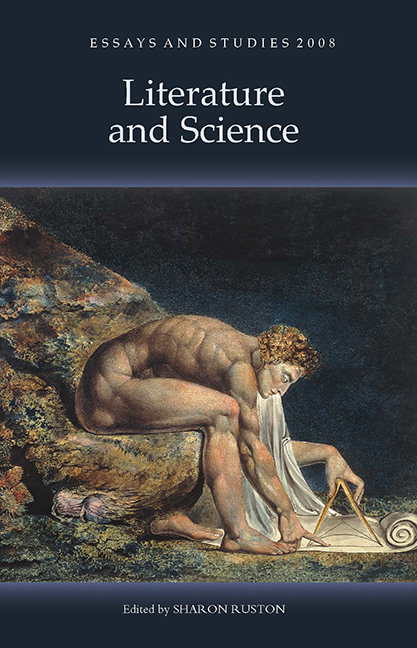Book contents
- Frontmatter
- Contents
- List of Illustrations
- Acknowledgements
- Notes on Contributors
- Introduction
- 1 From Popular Science To Contemplation: The Clouds Of The Cloud Of Unknowing
- 2 ‘Dreams And Plain Dotage’: The Value Of The Birth Of Mankind (1540–1654)
- 3 Natural Rights And Natural History In Anna Barbauld And Mary Wollstonecraft
- 4 George Eliot, Geometry And Gender
- 5 On The Back Of The Light Waves: Novel Possibilities In The ‘Fourth Dimension’
- 6 Le Fanu's ‘Carmilla’, Ireland, And Diseased Vision
- 7 Evolution, Literary History And Science Fiction
- 8 ‘The Luxury Of Storytelling’: Science, Literature And Cultural Contest In Ian Mcewan's Narrative Practice
- Index
7 - Evolution, Literary History And Science Fiction
Published online by Cambridge University Press: 12 February 2019
- Frontmatter
- Contents
- List of Illustrations
- Acknowledgements
- Notes on Contributors
- Introduction
- 1 From Popular Science To Contemplation: The Clouds Of The Cloud Of Unknowing
- 2 ‘Dreams And Plain Dotage’: The Value Of The Birth Of Mankind (1540–1654)
- 3 Natural Rights And Natural History In Anna Barbauld And Mary Wollstonecraft
- 4 George Eliot, Geometry And Gender
- 5 On The Back Of The Light Waves: Novel Possibilities In The ‘Fourth Dimension’
- 6 Le Fanu's ‘Carmilla’, Ireland, And Diseased Vision
- 7 Evolution, Literary History And Science Fiction
- 8 ‘The Luxury Of Storytelling’: Science, Literature And Cultural Contest In Ian Mcewan's Narrative Practice
- Index
Summary
THE FIRST LINE OF the Preface of George Levine's study of Darwinian discourse and its connection to the nineteenth-century novel, Darwin Among The Novelists (1988) quotes G. H. Lewes's remark ‘that “science is penetrating everywhere” ‘ (Levine 1988, vii). Twenty years later, this volume of Essays and Studies attests to the continuing, perhaps burgeoning, importance of scientific paradigms to literary study. Where some literary critics, such as N. Katherine Hayles, have taken up cybernetics and information theory as scientific theories by which to critique ‘postmodern’ or ‘posthuman’ constructions of the subject, it has been more usual for the biological, rather than the physical sciences, to provide the apparatus for experiments in science-inflected literary criticism. More specifically, it is Darwinian or evolutionary theory that has, in the last ten years or so, been the source for several attempts to re-invigorate the literary academy, in a moment which is being viewed as increasingly ‘after Theory’. It is my intention in this essay to consider several contemporary deployments of evolutionary thinking within the field of literary studies. I will analyse Franco Moretti's Graphs, Maps, Trees (2005), his attempt to construct different (scientific) models for literary history, and then apply his thinking to science fiction (SF), a major literary genre self-consciously set aside in Graphs, Maps, Trees. I will also consider the difference between Moretti's evolutionary paradigm and that used by the sociobiology-influenced critic Joseph Carroll, whose work, as will be seen, propagandizes for an evolutionary psychology but in fact masks a very traditional form of literary analysis.
In a series of three articles published in the New Left Review, and collected in Graphs, Maps, Trees, Moretti provides three different (though connected conceptually) ‘abstract’ models for understanding literary history. In Atlas of the European Novel (1998) Moretti had used a ‘mapping’ technique for spatially laying out certain elements from fictional texts in order to reveal underlying ideological or structural emphases. In the second article/chapter, on maps, Moretti expands upon and rethinks his cartographic methods from his Atlas. He notes a criticism made by the Italian geographer Claudio Cerreti, who pointed out:
how patterns entail a Cartesian reduction of space to extension, where ‘objects are analysed in terms of reciprocal positions and distances … whether they are close or far from each other is something else.’
- Type
- Chapter
- Information
- Literature and Science , pp. 131 - 150Publisher: Boydell & BrewerPrint publication year: 2008
- 2
- Cited by



